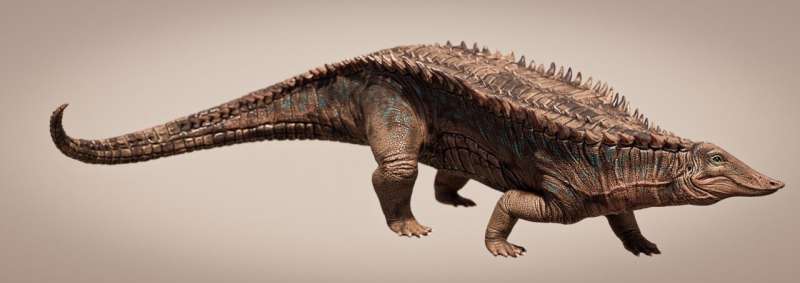While dinosaurs often steal the spotlight in discussions of prehistoric creatures, the Triassic period harbored a diverse array of fascinating organisms, including the formidable aetosaurs. These armored reptiles, akin to modern crocodiles, roamed the Earth before the rise of dinosaurs, leaving behind a legacy of heavily fortified fossils. Among them, Garzapelta muelleri emerges as a newfound species, shedding light on the evolutionary history of these enigmatic creatures. Led by William Reyes, a doctoral student at The University of Texas at Austin, a team of researchers unveils the remarkable discovery of Garzapelta, providing insights into its anatomy, lifestyle, and evolutionary significance.
Unraveling the Mysteries of Aetosaurs: Aetosaurs, commonly referred to as the “tanks of the Triassic,” possessed an impressive armor comprised of bony plates known as osteoderms. These formidable defenses shielded them from predators and conferred resilience in their ancient habitats. Despite their robust armor, aetosaurs eventually succumbed to extinction around 200 million years ago, leaving behind fossilized remnants that continue to captivate paleontologists worldwide.
The Discovery of Garzapelta muelleri: In a groundbreaking study published in The Anatomical Record, Reyes and his team unveil Garzapelta muelleri, a newly identified species of aetosaur. Remarkably, the specimen boasts a 70% complete carapace, offering unprecedented insights into the morphology and distribution of aetosaur armor. Named in honor of its discovery site in Garza County, Texas, and paleontologist Bill Mueller, Garzapelta represents a significant addition to the pantheon of prehistoric reptiles.
Aetosaurs: Crocodile Armadillos of the Triassic: Garzapelta muelleri inhabited the ancient landscapes approximately 215 million years ago, sporting a physique reminiscent of modern American crocodiles. However, its armored exterior and spiked flanks distinguished it as a unique member of the Triassic ecosystem. Resembling a hybrid between a crocodile and an armadillo, Garzapelta exemplifies the convergence of distinct evolutionary traits, highlighting nature’s remarkable adaptability.
Insights into Aetosaur Evolution: The study of Garzapelta’s osteoderms provides valuable insights into the evolutionary relationships among aetosaurs. Surprisingly, similarities in armor structure between Garzapelta and other species underscore the concept of convergent evolution, wherein unrelated organisms develop analogous traits in response to similar environmental pressures. While deciphering Garzapelta’s placement within the aetosaur family tree presented challenges, the researchers unraveled its evolutionary lineage through meticulous analysis of anatomical features.
Unveiling the Role of Museum Collections: Garzapelta’s discovery underscores the importance of museum collections in paleontological research. Specimens, often curated for decades, serve as invaluable resources for unraveling the mysteries of prehistoric life. Reyes’ encounter with Garzapelta in the Texas Tech University fossil collections exemplifies the serendipitous nature of scientific discovery, highlighting the role of dedicated researchers in breathing new life into ancient fossils.
Future Directions and Research Implications: As Reyes delves deeper into the study of aetosaur fossils, questions regarding variations in armor morphology based on age and sex emerge. By exploring these nuances, researchers aim to paint a comprehensive picture of aetosaur biology and ecology. Furthermore, Garzapelta’s discovery opens avenues for future investigations into the evolutionary adaptations of Triassic reptiles, offering tantalizing prospects for uncovering additional cryptic species and elucidating their role in prehistoric ecosystems.
The unveiling of Garzapelta muelleri represents a significant milestone in our understanding of Triassic reptiles and their evolutionary legacy. Through meticulous research and analysis, Reyes and his team have resurrected a long-lost inhabitant of ancient Texas, shedding light on the diversity and complexity of prehistoric life. As the story of Garzapelta unfolds, it serves as a testament to the enduring allure of paleontology and the boundless mysteries awaiting discovery within the fossil record.
